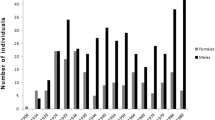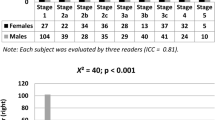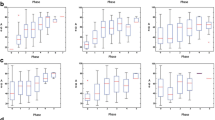Abstract
To evaluate the influence of bone loss on the three adult age markers of the innominate, 30 males and 30 females aged between 16 and 80 years coming from the British Coventry collection were analyzed. The pubic symphysis, auricular surface, and acetabulum age variables were evaluated following the descriptions of Schmitt, Buckberry-Chamberlain, and Rissech, respectively. The second metacarpal cortical index was used to evaluate bone loss. Possible sexual differences in metrical variables were explored by a Student t-test taking into account the entire sample. The possible relationships between the cortical index and the three age methods’ stages were assessed by the Kruskall-Wallis test and Spearman’s correlation coefficient. There were no sexual differences in the cortical index. In general, we observed no significant differences between the cortical index in the different stages of the pubic symphysis, auricular surface, or acetabulum variables in men and women. Most correlation coefficients are negatives, and their absolute values are between 0.001 and 0.44, indicating an extremely low influence of bone loss on the analyzed variables. Our findings suggest little influence of bone loss in the three ageing methods. However, further research on this topic is necessary. This is the first study to analyze the influence of bone loss in the ageing changes undergone by the variables of the three adult age indicators of the innominate taking into account both sexes.







Similar content being viewed by others
References
Todd TW (1921) Age changes in the pubic bones. II. The pubis of the male negro-white hybrid. III. The pubis of the white female. IV. The pubis of the female negro-white hybrid. Am J Phys Anthropol 4:4–70
Brooks S, Suchey J (1990) Skeletal age determination based on the os pubis: a comparison of the Acsadi-Nemekeri and Suchey-Brooks methods. Hum Evol 5:227–238
Schmitt A (2001) Variabilité de la sénescence du squelette humain. Réflexions sur les indicateurs de l’âge au décès: à la recherche d’un outil performant, Ph.D. dissertation, Universite de Bordeaux I, Bordeaux
Lovejoy CO, Meindl RS, Prysbeck TR, Mensforth RP (1985) Chronological metamorphosis of the auricular surface of the ilium: a new method for the determination of adult skeletal age at death. Am J Phys Anthropol 68:15–28
Murray K, Murray T (1991) A test of the auricular surface aging technique. J Forensic Scien 36:1162–1169
Buckberry JL, Chamberlain AT (2002) Age estimation from the auricular surface of the ilium: a revised method. Am J Phys Anthropol 119:231–239
Rissech C, Estabrook GF, Cunha E, Malgosa A (2006) Using the acetabulum to estimate age at death of adult males. J Forensic Sci 51:213–219
Rissech C, Estabrook GF, Cunha E, Malgosa A (2007) Estimation of age at death for adult males using the acetabulum, applied to four western European populations. J Forensic Scien 52:774–779
Rissech C, Schmitt A, Malgosa A, Cunha E (2004) Influencia de las patologías en los indicadores de edad adulta del coxal: estudio preliminar. Antropologia Portuguesa 20/21:267–279
Mays S (2012) An investigation of age–related changes at the acetabulum in 18th–19th century AD adult skeletons from Christ Church Spitalfields, London. Am J Phys Anthropol 149:485–492
Mays S (2015) The effect of factors other than age upon skeletal age indicators in the adult. Ann Hum Biol 42:332–341
Schmitt A, Wapler V, Couallier V, Cunha E (2007) Are bone losers distinguishable from bone formers in a skeletal series? Implications for adult age at death assessment methods. Homo 58:53–66
San-Millán M, Rissech C, Turbón D (2017) Shape variability of the adult human acetabulum and acetabular fossa related to sex and age by geometric morphometrics. Implications for adult age estimation. Forensic Sci Int 272:50–63
Lucy D, Aykroyd RG, Pollard AM, Solheim T (1996) A Bayesian approach to adult human age estimation from dental observations by Johanson’s age changes. J Forensic Sci 41:189–194
Resnick D, Niwayama G (1988) Diagnosis of bone and joint disorders, 2nd edn. W B Saunders Company, Toronto
Campo-Martín M (2003) Paleopatología de la columna vertebral. In: Isidro, A.; Malgosa, A. (eds). Paleopatología, la enfermedad no escrita. Masson, Barcelona, pp 163–193
Hopewell PH (1994) Overview of clinical tuberculosis. In: Bloom BR (ed) Tuberculosis: pathogenesis, protection and control. ASM Press, Washington DC, pp 25–46
Rissech C, Schmitt A, Cunha E, Malgosa A (2004) Estimación de la edad adulta masculina a través del acetábulo. In: Egocheaga JE (ed) Biologia de las poblaciones humanas: diversidad, tiempo, espacio. Actas del XIII Congreso de la Sociedad Española de Antropologia Biológica. Oviedo, 15–18 Septiembre 2003. Universidad de Oviedo, Oviedo, pp 219–227
McKern TW, Stewart TW (1957) Skeletal age changes in young American males. Analysis from the stand point of age identification. Environmental Protection Research Division, Technical Report n°EP45
Meindl RS, Lovejoy CO, Mensforth RP, Walker RA (1985) A revised method of age determination using the os pubis, with a review and tests of accuracy of other current methods of pubic symphyseal aging. Am J Phys Anthropol 68:29–45
Meindl RS, Russel KF (1997) Recent advances in method and theory in paleodemography. Annual Revue Anthropol 27:375–399
Soden I (2001) Excavations at the Cathedral Church of St Mary, Coventry 1999–2000. Summary Report. Northamptonshire Archaeology
Jannin K (2014) Sex assessment on the basis of humeral and femoral heads: perspective from post-medieval British urban populations. Dissertation for the degree of BA in Archaeology. School of Archaeology and Ancient History at the University of Leicester, UK
Weaver DS (1979) Application of the likelihood ratio test to age estimation using the infant and child temporal bone. Am J Phys Anthropol 50:263–270
Brothwell DR (1981) Digging up bones. The excavation, treatment and study of human skeletal remains. Cornel University Press
Krogman WM, Iscan MY (1986) The human skeleton in forensic medicine, 2nd edition. C.C. Thomas, Springfield
Schutkowski H (1987) Sex determination of fetal and neonate skeletons by means of discriminant analysis. Int J Anthropol 2:347–352
Schutkowski H (1993) Sex determination of infant and juvenile skeletons: I Morphognostic features. Am J Phys Anthropol 90:199–205
Ubelaker DH (1989) Human skeletal remains. Excavation, analysis, interpretation. Manuals on Archaeology 2 (2nd edn). Washington Taraxacum, Washington DC
Black S, Scheuer L (1996) Age changes in the clavicle: from the early neonatal period to skeletal maturity. Int J Osteoarchaeol 6:425–434
Ferembach D, Schwidetzky I, Weston D (1980) Recommendation for age and sex diagnosis skeletons. J Hum Evol 9:517–549
Rissech C, Malgosa A (1997) Sex prediction by discriminant function with central portion measures of innominate bones. Homo 48:22–32
Murail P, Bruzek J, Houët F, Cunha E (2005) A tool for probabilistic sex diagnosis using woldwide variability in hip bone measurements. Bull Mém Soc Antrop Paris 17:3–4
Mays S, Cox M (2000) Sex determination in skeletal remains. In: Cox M, Mays S (eds) Human osteology in archaeology and forensic science. Greenwich Medical Media, London, pp 117–130
Hens S, Rastelli E, Belcastro G (2008) Age estimation from the human os coxa: a test on a documented Italian collection. J Forensic Sci 53:1040–1043
Falys CG, Schutkowski H, Weston DA (2006) Auricular surface aging. Worse than expected? A test of revised method on a documented historic skeletal assemblage. Am J Phys Anthropol 130:508–513
San-Millán M, Rissech C, Turbón D (2016) New approach to age estimation of male and female adult skeletons based on the morphological characteristics of the acetabulum. Int J Legal Med. doi:10.1007/s00414-016-1406-4
Mays S (1996) Age-dependent cortical bone loss in a medieval population. Int J Osteoarchaeol 6:144–154
Mays S (2000) Age-dependent cortical bone loss in women from 18th and early 19th century London. Am J Phys Anthropol 112:349–361
Schmitt A (2004) Age-at-death assessment using the os pubis and the auricular surface of the ilium: a test on an identified Asian sample. Int J Osteoarchaeol 14:1–16
Miranker M (2015) Atest of the performance of three age indicators of the adult human pelvis and the influence of occupation on morphology. Master’s dissertation, New York University
Ives R, Brickley M (2005) Metacarpal radiogrammetry: a useful indicator of bone loss throughout the skeleton? J Archaeol Sci 32:1552–1559
Parfitt AM (2003) New concepts of bone remodelling: a unified spatial and temporal model with physiologic and pathophysiologic implications. In: Agarwal S, Stout S (eds) Bone loss and osteoporosis. An anthropological perspective. Kluwer Academic, New York, pp 3–17
Frost H (2003) On changing views about age-related bone loss. In: Agarwal S, Stout S (eds) Bone loss and osteoporosis, an anthropological Perspective. Kluwer Academic, New York, pp 19–31
Mays S (2001) Effects of age and occupation on cortical bone in a group of 18the19th century British men. Am J Phys Anthropol 116:34–44
Barnett E, Nordin BEC (1960) The radiological diagnosis of osteoporosis: a new approach. Clinic Radiolol 11:166–174
Van Hemert AM, Vandenbroucke JP, Hofman A, Valkenburg HA (1990) Metacarpal bone loss in middle-aged women: ‘horse racing’ in a 9-year population based follow-up study. J Clinic Epidemiol 43:579–588
Wishart JM, Horowitz M, Bochner M, Need AG, Nordin BEC (1993) Relationship between metacarpal morphometry, forearm and vertebral bone density and fractures in post-menopausal women. Br J Radiol 66
Derisquebourg T, Dubois P, Devogelaer JP, Meys E, Duquesnoy B, Nagant de Deuxchaisnes C, Delcambre B, Marchandis X (1994) Automated computerised radiogrammetry on the second metacarpal and its correlation with absorbtiometry of the forearm and spine. Calcif Tissue Int 54:461–465
Ragi S, Lewiecki EM (2006) Peripheral bone densitometry—clinical applications. Arq Bras Endocrinol Metab 50:596–602
Lees B, Molleson T, Arnett TR, Stevenson JC (1993) Differences in proximal femur bone density over two centuries. Tbe Lancet 341:673–675
Kniessel M, Boyde A, Hahn M, Teschler-Nicola M, Kalchhauser G, Plenk H (1994) Age and sex dependent cancellous bone changes in a 4000y BP population. Bone 15:539–545
Bell LS, Jones SJ (1991) Macroscopic and microscopic evaluation of archaeological pathological bone: backscattered electron imaging of putative pagetic bone. Int J Osteoarchaeol 1:179–184
Curate F (2014) Osteoporosis and paleopathology: a review. J Archaeol Sci 92:119–146
Rissech C (2013) Letter to the editor: comments on “A new method to estimate adult age-at-death using the acetabulum” (Calce, 2012). Am J Phys Anthropol 151:331–332
Schneider DL, Barrett-Connor E, Morton DJ, Weisman M (2002) Bone mineral density and clinical hand osteoarthritis in elderly men and women: the Rancho Study. J Rheumatol 29:1467–1472
Rissech C, Wilson G, Winburn AP, Turbón D, Steadman D (2012) A comparison of three established age estimation methods on an adult Spanish sample. Int J Legal Med 126:145–155
San-Millán M, Rissech C, Turbón D (2013) A test of SucheyeBrooks (pubic symphysis) and BuckberryeChamberlain (auricular surface) methods on an identified Spanish sample: paleodemographic implications. J Archaeol Sci 40:1743–1751
Campanacho V, Santos AL, Cardoso HFV (2012) Assessing the influence of occupational and physical activity on the rate of degenerative change of the pubic symphysis in Portuguese males from the 19th - 20th century. Am J Phys Anthropol 148:371–378
Merritt CE (2015) The influence of body size on adult skeletal age estimation methods. Am J Phys Anthropol 156:35–57
Wescott DJ, Drew JL (2015) Effect of obesity on the reliability of age-at-death indicators of the pelvis. Am J Phys Anthropol 156:595–605
Campanacho V (2016) Influence of skeletal size on age-related criteria from the pelvic joints in Portuguese and American samples. PhD Thesis, University of Sheffield, Department of Archaeology
Taylor KM (2000) The effects of alcohol and drug abuse on the sternal end of the fourth rib. PhD Dissertation. Department of Anthropology, University of Arizona
Hartnett KM (2007) A re-evaluation and revision of pubic symphysis and fourth rib aging techniques. PhD thesis. Arizona State University
Passalacqua N (2014) Drug use, homeostasis, and the estimation of age at death from skeletal remains. Poster presented at the American Academy of Forensic Sciences Meeting
Hoppa RD (2000) Population variation in osteological aging criteria: an example from the pubic symphysis. Am J Phys Anthropol 111:185–191
Rissech C, Sañudo JR, Malgosa A (2001) Acetabular point: a morphological and ontogenetic study. J Anat 198:743–748
Hengen OP (1971) Cribra orbitalia: pathogenesis and probable etiology. Homo 22:57–75
Author information
Authors and Affiliations
Corresponding author
Rights and permissions
About this article
Cite this article
Rissech, C., Appleby, J., Cosso, A. et al. The influence of bone loss on the three adult age markers of the innominate. Int J Legal Med 132, 289–300 (2018). https://doi.org/10.1007/s00414-017-1604-8
Received:
Accepted:
Published:
Issue Date:
DOI: https://doi.org/10.1007/s00414-017-1604-8




